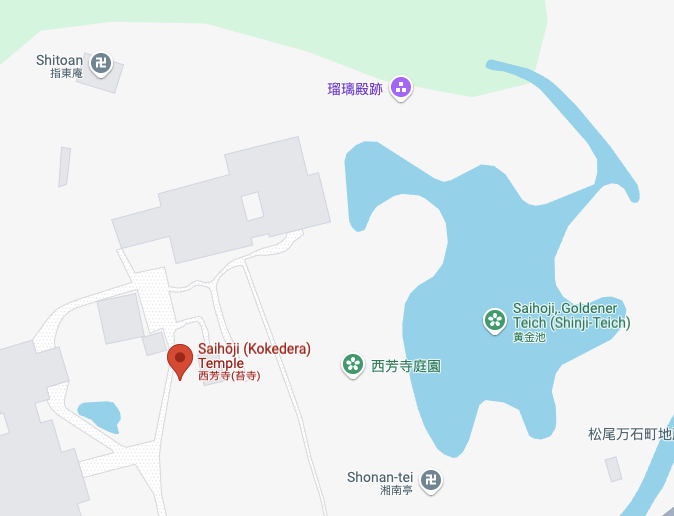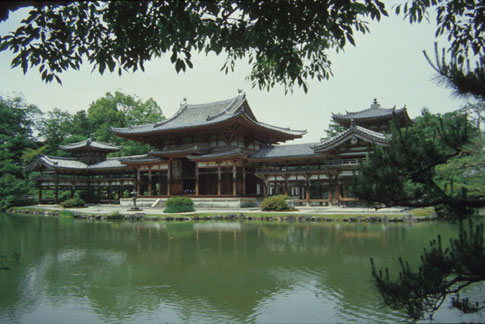
Popularly known as Kokedera (Moss Temple) because of the prevailing ground cover of the garden, Saiho-ji is one of the earliest extant gardens to be associated with Zen thought. It is a large pond garden that was once part of a Jodo temple, in which context it would have evoked the Western Paradise of Amida. When the temple was converted to Zen Buddhism by Muso Soseki in 1339, the garden was probably altered to some degree, and Muso is said to have added the rock formations of the upper level. The garden one visits today--heavily wooded and missing the various pavilions that Muso erected on the site--is certainly different from that of the fourteenth century, but it still evokes both the Pure Land of its original Jodo dedication and the reverance for nature shared by Shinto and Zen. Choose a view point from the map or click Tour the Garden for more views.
The garden of the temple of Saiho-ji is located in Nishigyo Ward of Western Kyoto. It is one of the earliest extant gardens to be associated with Zen Buddhism. Popularly known as Kokedera (Moss Temple) because of the prevailing ground cover of the garden, Saiho-ji entered the sphere of Rinzai Zen when Muso Soseki restored the temple in 1339, converting it from its former Jodo dedication to a Zen establishment and changing its name from Temple of Westward Direction to Temple of Western Fragrance. The origins of the pond garden that now lie to the east of the temple are obscure, possibly dating back to the Asuka Period (the site is supposed to have been that of a villa owned by Prince Shotoku). In the Tempyo epoch of the Nara Period, a temple dedicated to Amida was founded on the site, and it is likely that the pond and surrounding garden, which may once have been larger than its current area, was thought to represent the Pure Land, or Western Paradise. When Muso took over the temple in the fourteenth century he may have altered the design of the garden, but his role in creating its various features is conjectural. It is said that the pond itself, alternately named Kogane-ike or Ogonchi, is designed in the shape of the kanji character for heart (shin), and that this was Muso's intention, but there is no direct evidence of such an association. It is clear, however, that Muso saw to the construction of a number of subsidiary buildings that once stood beside the pond and on at least one of its islands, structures that were reported to have been connected by roofed corridors. This practice of having buildings "join" the garden rather than confront it is a marked departure from the typical Heian garden, and may indicate the influence of Chinese gardens. On the other hand, the interweaving of architecture and nature is not alien to Japanese culture and may have developed quite independently. One of Muso's structures, a two-story pavilion erected on the northern shore and known as Ruri-den, inspired the Silver Pavilion at Ginkaku-ji. The pond was also provided with a boat house and a covered bridge. None of these structures survives, although the man-made bank on which the abbot's residence stood can still be seen on the southern shore of the pond.
The garden today consists of two parts: the pond with its islands and surrounding path, and an upper section famous for its two rock formations, which are said to be the earliest examples of kare san sui and to have been designed by Muso himself. One of these is supposedly in the form of a turtle (a Turtle Island: kame shima), the other a dry cascade (kare taki). Although one can assume that these arrangements do date back to Muso's time, the appearance of the garden as a whole must certainly have changed radically over the centuries. The carpet of moss for which the site is famous--it is said that there are 120 varieties represented--is unlikely to have been a feature of the original garden, and may actually be the result of later neglect. The forest of trees that now dominates the site is obviously not contemporary with Muso's residency, but the Sakuteiki indicates that trees were an important part of the gardens of the Heian nobility, and there is no reason to believe that Saiho-ji was not originally wooded. The garden is described in a number of letters and diaries written by visitors to the site, all of them ecstatic about its beauty, but they are of little use in establishing its original appearance or the nature of its details. As altered as it may be, the garden as it exists today still casts a remarkable spell upon the visitor, evoking both the Pure Land of its original Jodo dedication and the stillness of Zen.
Although the garden was once contemplated from a number of pavilions, and at least at one point in its history was obviously a boating garden, it is now a stroll garden designed for circumambulation. This web site offers the viewer a virtual tour of the garden with a series of views arranged in the order in which one would encounter them in walking counterclockwise around the pond and then on to the upper garden. You may use the map for navigation, or you may simply keep clicking on the "next" button.

